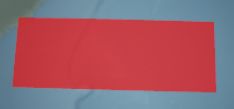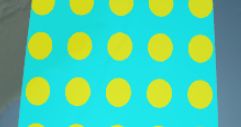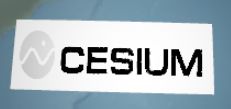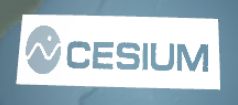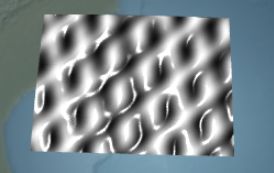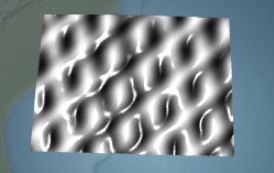https://github.com/AnalyticalGraphicsInc/cesium/wiki/Fabric
Fabric
Contents
- Introduction
- Built-In Materials
- Procedural Textures
- Base Materials
- Polyline Materials
- Misc Materials
- Common Uniforms
- Creating New Materials
- Components
- Source
- Input
- Combining Materials
- Fabric Schema
- Materials in the Rendering Pipeline
Introduction
Fabric is a JSON schema for describing materials in Cesium. Materials represent the appearance of an object such as polygons, polylines, ellipsoids, and sensors.
Materials can be as simple as draping an image over an object, or applying a pattern such as stripes or a checkerboard. Using Fabric and GLSL, new materials can be scripted from scratch or created by combining existing materials in a hierarchy; for example, wet crumbling bricks can be created with a combination of procedural brick, bump map, and specular map materials.



Objects that support materials have a material property. Currently, these objects are polygons, polylines, ellipsoids, and sensors. Materials are applied by assigning to the object's materialproperty.
polygon.material = Material.fromType('Color');
Above, Color is a built-in material which represents a single color, including alpha.Material.fromType is shorthand; the entire Fabric JSON can also be provided.
polygon.material = new Cesium.Material({
fabric : { type : 'Color' } });
Each material has zero or more uniforms, which are input parameters that can be specified when creating the material and modified after. For example, Color has a color uniform with red, green, blue, and alpha components.
polygon.material = new Cesium.Material({
fabric : { type : 'Color', uniforms : { color : new Cesium.Color(1.0, 0.0, 0.0, 0.5) } } }); // Change from translucent red to opaque white polygon.material.uniforms.color = Cesium.Color.WHITE;
Built-In Materials
Cesium has several built-in materials. Two widely used ones are:
All built-in materials can be created similar to how we used Color above. For example:
polygon.material = Material.fromType('Image'); polygon.material.uniforms.image = 'image.png';
or
polygon.material = new Cesium.Material({
fabric : { type : 'Image', uniforms : { image : 'image.png' } } });
Procedural Textures
Procedural texture materials procedurally compute patterns on the GPU so they do not rely on external image files. They represent both diffuse and alpha components.
Base Materials
Base materials represent fine-grain fundamental material characteristics, such as how much incoming light is reflected in a single direction, i.e., the specular intensity, or how much light is emitted, i.e., the emission. These materials can be used as is, but are more commonly combinedusing Fabric to create a more complex material.
Polyline Materials
Polyline materials are materials that can only be added to lines.
| Name | Screenshot | Description |
|---|---|---|
PolylineArrow |
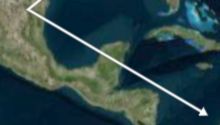 |
Places an arrow head at the end point of a line. |
PolylineGlow |
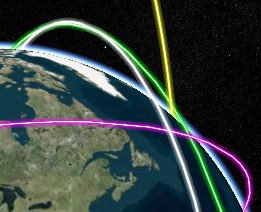 |
Makes glowing lines. |
PolylineOutline |
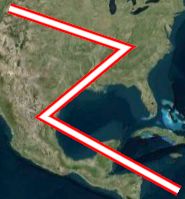 |
Line outline. |
Misc Materials
There are a few materials that do not fit into any other category.
| Name | Screenshot | Description |
|---|---|---|
Water |
 |
Animating water with waves and ripples. |
RimLighting |
 |
Highlights the rim or silhouette. |
For more materials, see the Cesium Materials Plugin.
Common Uniforms
Many materials have a image uniform, which is an image URL or data URI.
polygon.material.uniforms.image = 'image.png'; polygon.material.uniforms.image = 'data:image/png;base64,iVBORw0KGgoAAAANSUhEUgAAABAAAAAQCAYAAAAf8/9hAAAAAXNSR0IArs4c6QAAAARnQU1BAACxjwv8YQUAAAAJcEhZcwAADsMAAA7DAcdvqGQAAAC/SURBVDhPrZPRDYQgEEQpjVKuFEvhw0IoxU6QgQwMK+vdx5FsooT3GHdjCM4qZnnnHvvkYoxFi/uvIhwiRCClXFC6v5UQ1uQAsbrkHCLsbaPjFgIzQQc1yUOwu33ePGE3BQUaee2BpjhbP5YUmkAlbNzsAURfBDqJnMIyyv4JjsCCgCnIR32uZUfcJuGBOwEk6bOKhoAADh31EIq3MgFg1mgkE1BA2AoUZoo2iZ3gyqGgmMDC/xWwkfb3/eUd7A1v3kxjNW9taQAAAABJRU5ErkJggg=='
Some materials, such as Diffuse and NormalMap require images with three components per pixel; other materials, such as Specular and Alpha, require one component. We can specify what channels (and in what order) these components are pulled from when creating a material using the channels or channel string uniform. For example, by default in the Specular material, the specular component is taken from the r channel. However, we can change that:
polygon.material = new Cesium.Material({
fabric : { type : 'SpecularMap', uniforms : { image : 'specular.png', channel : 'a' } } });
This allows packing data for multiple materials into the same image, e.g., storing diffuse components as rgb and specular components as a in the same image. Under the hood, the image will also be loaded once.
Materials that use images often have a repeat uniform that controls the number of times the image repeats horizontally and vertically. This can be useful for tiling images across a surface.
polygon.material = new Cesium.Material({
fabric : { type : 'DiffuseMap', uniforms : { image : 'diffuse.png', repeat : { x : 10, y : 2 } } } });
Creating New Materials
New materials are created using Fabric, a bit of GLSL, and potentially other materials.
If a material is not going to be reused, it can be created without a type.
var fabric = {
// no type
// ...rest of fabric JSON }; polygon.material = new Cesium.Material({ fabric : fabric });
When a non-existing type is used, the material is cached during the first call to new Cesium.Material, and later calls to new Cesium.Material or Material.fromType can reference the material as if it were a built-in material, i.e., they don't need to provide the full Fabric, just the typeand any uniforms they want to set.
var fabric = {
type : 'MyNewMaterial', // ...rest of fabric JSON }; polygon.material = new Cesium.Material({ fabric : fabric }); // ... later calls just use the type. anotherPolygon.material = Material.fromType('MyNewMaterial');
Components
Perhaps the simplest interesting material is one that reflects white in all directions:
var fabric = {
components : {
diffuse : 'vec3(1.0)' } }
A slightly more complicated example adds a specular component so that the material's reflected light is most intense when viewed straight down, and becomes less intense as viewed edge-on.
{
components : {
diffuse : 'vec3(0.5)',
specular : '0.1' } }
The components property contains sub-properties that define the appearance of the material. The value of each sub-property is a GLSL code snippet, hence the vec3(0.5) above, which creates a 3D vector with each component set to 0.5. These have access to all GLSL functions like mix, cos, texture2D, etc. There are five sub-properties.
| Name | Default | Description |
|---|---|---|
diffuse |
'vec3(0.0)' |
The diffuse component of this material. The diffuse component is a vec3 defining incoming light that scatters evenly in all directions. |
specular |
0.0 |
The specular component of this material. The specular component is a float defining the intensity of incoming light reflecting in a single direction. |
shininess |
1.0 |
The sharpness of the specular reflection. Higher values create a smaller, more focused specular highlight. |
normal |
The normal component of this material. The normal component is a vec3 defining the surface's normal in eye coordinates. It is used for effects such as normal mapping. The default is the surface's unmodified normal. |
|
emission |
'vec3(0.0)' |
The emission component of this material. The emission component is a vec3 defining light emitted by the material equally in all directions. The default is vec3(0.0), which emits no light. |
alpha |
1.0 |
The alpha component of this material. The alpha component is a float defining the opacity of this material. 0.0 is completely transparent; 1.0 is completely opaque. |
Together, these sub-properties, or components define the characteristics of the material. They are the output of the material, and the input to the lighting system.
Source
An alternative to the components property that provides more flexibility is to provide complete GLSL source for a function, czm_getMaterial, that returns the material's components. The signature is:
struct czm_materialInput
{
float s;
vec2 st;
vec3 str;
mat3 tangentToEyeMatrix;
vec3 positionToEyeEC; vec3 normalEC; }; struct czm_material { vec3 diffuse; float specular; float shininess; vec3 normal; vec3 emission; float alpha; }; czm_material czm_getMaterial(czm_materialInput materialInput);
The simplest possible implementation is to return the default for each component.
czm_material czm_getMaterial(czm_materialInput materialInput)
{
return czm_getDefaultMaterial(materialInput);
}
The Fabric looks like:
{
source : 'czm_material czm_getMaterial(czm_materialInput materialInput) { return czm_getDefaultMaterial(materialInput); }'
}
Our example material above that sets diffuse and specular components can be implemented as:
czm_material czm_getMaterial(czm_materialInput materialInput)
{
czm_materialInput m = czm_getDefaultMaterial(materialInput);
m.diffuse = vec3(0.5);
m.specular = 0.5; return m; }
Using source instead of components is more verbose, but provides more flexibility, including the ability to share common computations for different components and to make utility functions. A rule of thumb is to use the components property unless the flexibility of explicitly implementing czm_getMaterial is needed. Under the hood, the components sub-properties are used to implement czm_getMaterial. In both cases, we have access to GLSL built-in functions and Cesium provided built-in GLSL functions, uniforms, and constants.
Input
The materialInput variable is available in both source and components. It has the following fields that can be used to compute material components.
| Name | Type | Description |
|---|---|---|
s |
float |
A 1D texture coordinate. |
st |
vec2 |
2D texture coordinates. |
str |
vec3 |
3D texture coordinates. The 1D, 2D, and 3D texture coordinates are not necessarily proper subsets of each other, e.g., str.st == st and st.s == s are not guaranteed. For example, for an ellipsoid, s might go from bottom to top; st might be longitude and latitude; and str might be along the axes of the bounding box. |
tangentToEyeMatrix |
mat3 |
A transformation matrix from the fragment's tangent space to eye coordinates, for normal mapping, bump mapping, etc. |
positionToEyeEC |
vec3 |
A vector from the fragment to the eye in eye coordinates, for reflection, refraction, etc. The magnitude is the distance in meters from the fragment to the eye. |
normalEC |
vec3 |
The fragment's normal (normalized) in eye coordinates, for bump mapping, reflection, refraction, etc. |
A simple material that visualizes the st texture coordinates is:
{
components : {
diffuse : 'vec3(materialInput.st, 0.0)'
}
}
Similarly, we can visualize the normal in eye coordinates by setting diffuse to materialInput.normalEC.
In addition to materialInput, materials have access to uniforms, both Cesium provided built-in uniforms and uniforms specific to the material. For example, we can implement our own Colormaterial by setting the diffuse and alpha components based on a color uniform.
{
type : 'OurColor',
uniforms : {
color : new Color(1.0, 0.0, 0.0, 1.0) }, components : { diffuse : 'color.rgb', alpha : 'color.a' } }
In Fabric, the uniform property's sub-properties are the names of the uniforms in GLSL and the JavaScript object returned from new Material and Material.fromType. The sub-properties's values (for scalars) or sub-properties (for vectors) are the value of the uniform.
We can implement our own DiffuseMap material by using an image uniform:
{
type : 'OurDiffuseMap',
uniforms : {
image : 'czm_defaultImage' }, components : { diffuse : 'texture2D(image, materialInput.st).rgb' } }
Above, 'czm_defaultImage' is a placeholder 1x1 image. As discussed earlier, this can also be an image URL or data URI. For example, a user would create an OurDiffuseMap like:
polygon.material = Material.fromType('OurDiffuseMap'); polygon.material.uniforms.image = 'diffuse.png';
There is also a cube-map placeholder, czm_defaultCubeMap. The standard GLSL uniform types, float, vec3, mat4, etc. are supported. Uniform arrays are not supported yet, but are on the roadmap.
Combining Materials
So far, we can use the built-in materials, or create our own by using Fabric to specify the material's components or full GLSL source. We can also build materials from existing materials (recursively) forming a hierarchy of materials.
Fabric has a materials property where the value of each sub-property is Fabric, i.e., a material. These materials can be referenced in the components and source properties so they can be built upon. For example, a material representing plastic can be implemented with a DiffuseMap and SpecularMap.
{
type : 'OurMappedPlastic',
materials : {
diffuseMaterial : { type : 'DiffuseMap' }, specularMaterial : { type : 'SpecularMap' } }, components : { diffuse : 'diffuseMaterial.diffuse', specular : 'specularMaterial.specular' } };
This material has diffuse and specular components that pull values from materials in the materials property. The sub-materials are named diffuseMaterial and specularMaterial(created from types DiffuseMap and SpecularMap; do not confuse the name - the instance - and the type - the class so to speak). In the components and source properties, sub-materials are accessed by name as if they were an czm_material structure, hence the .diffuse and .specularfield accesses above.
Given this Fabric, our material can be used like other materials.
var m = Material.fromType('OurMappedPlastic'); polygon.material = m; m.materials.diffuseMaterial.uniforms.image = 'diffuseMap.png'; m.materials.specularMaterial.uniforms.image = 'specularMap.png';
TODO: links to reference doc.
TODO: links to Sandcastle.
TODO: need simple but inspiring examples of writing custom materials with Fabric.
Fabric Schema
A JSON Schema for Fabric is in the Cesium repo. This details all Fabric properties and sub-properties, including type, materials, uniforms, components, and source. There are several JSON examples showing the schema, but not necessarily interesting visuals.
In addition to more rigorous Fabric documentation, the schema can be used to validate Fabric using a tool like JSV.
Materials in the Rendering Pipeline
Objects like Polygon, PolylineCollection, Ellipsoid, CustomSensorVolume, etc. integrate with the material system to support materials. Most users will simply assign to their material property and be done. However, users writing custom rendering code may also want to integrate with materials. Doing so is straightforward.
From the rendering perspective, a material is a GLSL function, czm_getMaterial, and uniforms. The fragment shader needs to construct an czm_MaterialInput, call czm_getMaterial, and then pass the resulting czm_material to the lighting function to compute the fragment's color.
In JavaScript, the object should have a public material property. When this property changes, the update function should prepend the material's GLSL source to the object's fragment shader's source, and combine the uniforms of the object and the material.
var fsSource =
this.material.shaderSource + ourFragmentShaderSource; this._drawUniforms = combine([this._uniforms, this.material._uniforms]);
---------------------------------------------------------------------------------------------------
Cesium默认提供了十八个类型Type:
- Color
- Image
- DiffuseMap
- AlphaMap
- SpecularMap
- EmissionMap
- BumpMap
- NormalMap
- Grid
- Stripe
- Checkerboard
- Dot
- Water
- RimLighting
- Fade
- PolylineArrow
- PolylineGlow
- PolylineOutline
当然,Cesium支持多个Type的叠加效果,如下是DiffuseMap和NormalMap的一个叠加,components中指定material中diffuse、specular、normal的映射关系和值:
primitive.appearance.material = new Cesium.Material({
fabric : {
materials : {
applyDiffuseMaterial : {
type : 'DiffuseMap',
uniforms : {
image : '../images/bumpmap.png'
}
},
normalMap : {
type : 'NormalMap',
uniforms : {
image : '../images/normalmap.png',
strength : 0.6
}
}
},
components : {
diffuse : 'diffuseMaterial.diffuse',
specular : 0.01,
normal : 'normalMap.normal'
}
}
});
当然,这些都满足不了你的欲望?你也可以自定义一个自己的MaterialType,我们先了解Cesium.Material的内部实现后,再来看看自定义Material。
